Dynamic Characterization of Microscopic Pore Structure in Medium–High Permeability Sandstones During Waterflooding
Abstract
1. Introduction
2. Materials and Methods
2.1. Sandstone Rock Samples
2.2. Analysis in the Representative Element Volume of Porous Structures
3. Results and Discussion
3.1. Pore Size Distribution of Porous Structures
3.2. A New Classification of Local Pore Structure
- (1)
- Representative Sampling: It is assumed that for each permeability range within the target sandstone reservoir, a representative core exists whose pore structure reflects typical flow characteristics for that reservoir zone. In this study, one core was selected from both medium-permeability and high-permeability zones.
- (2)
- Representative Elementary Volume (REV): It is assumed that an REV can be established for each selected core, allowing for stable statistical description of microstructural features within a finite digital volume.
- (3)
- Low-Velocity Flow Regime: The model assumes low flow velocities, under which the effects of inertial forces and non-laminar behavior can be neglected. This assumption is consistent with flow conditions in subsurface reservoirs.
- (4)
- Image Resolution Constraints: The digital core reconstructions are based on high-resolution CT scans, which inherently limit the smallest resolvable features. Therefore, pores and throats below the resolution threshold (typically <1 µm) are not included in the analysis. This implies that the model may underestimate total porosity or misrepresent nanoporous domains in real rock.
- (5)
- Flow-Relevant Parameters: The classification relies on pore diameter and flow flux area as key indicators of local flow capacity and connectivity. It is assumed that these geometric features adequately capture the relevant flow heterogeneity at the pore scale.
3.3. Porous Structure Variation During Long-Term Waterflooding
3.3.1. Statistical Characteristics Variation of Porous Structure
3.3.2. Evolution Characteristics for Different Pore Types
4. Conclusions
Author Contributions
Funding
Data Availability Statement
Conflicts of Interest
Abbreviations
| SEM | Scanning electron microscopy |
| Micro-CT | Micro-computed tomography |
| FIB-SEM | Focused ion beam-scanning electron microscopy |
| NMR | Nuclear magnetic resonance |
| REV | Representative element volume |
| LBM | Lattice Boltzmann method |
| PV | Pore volume |
Appendix A. Micro-CT Imaging Setup and Data Analysis Description
Appendix A.1. Micro-CT Imaging Equipment and Parameters
- Model: X-radia MicroXCT-400;
- Nominal spatial resolution: ~3.5 μm per voxel;
- X-ray source: Tungsten anode with adjustable voltage (40–150 kV) and power (up to 10 W);
- Detector type: 4× sCMOS-based camera system;
- Sample size: Up to 40 mm in diameter;
- Field of View (FOV): 8–25 mm (depending on resolution setting);
- Scanning mode: 360° full rotation with 1000–1600 projections per sample.
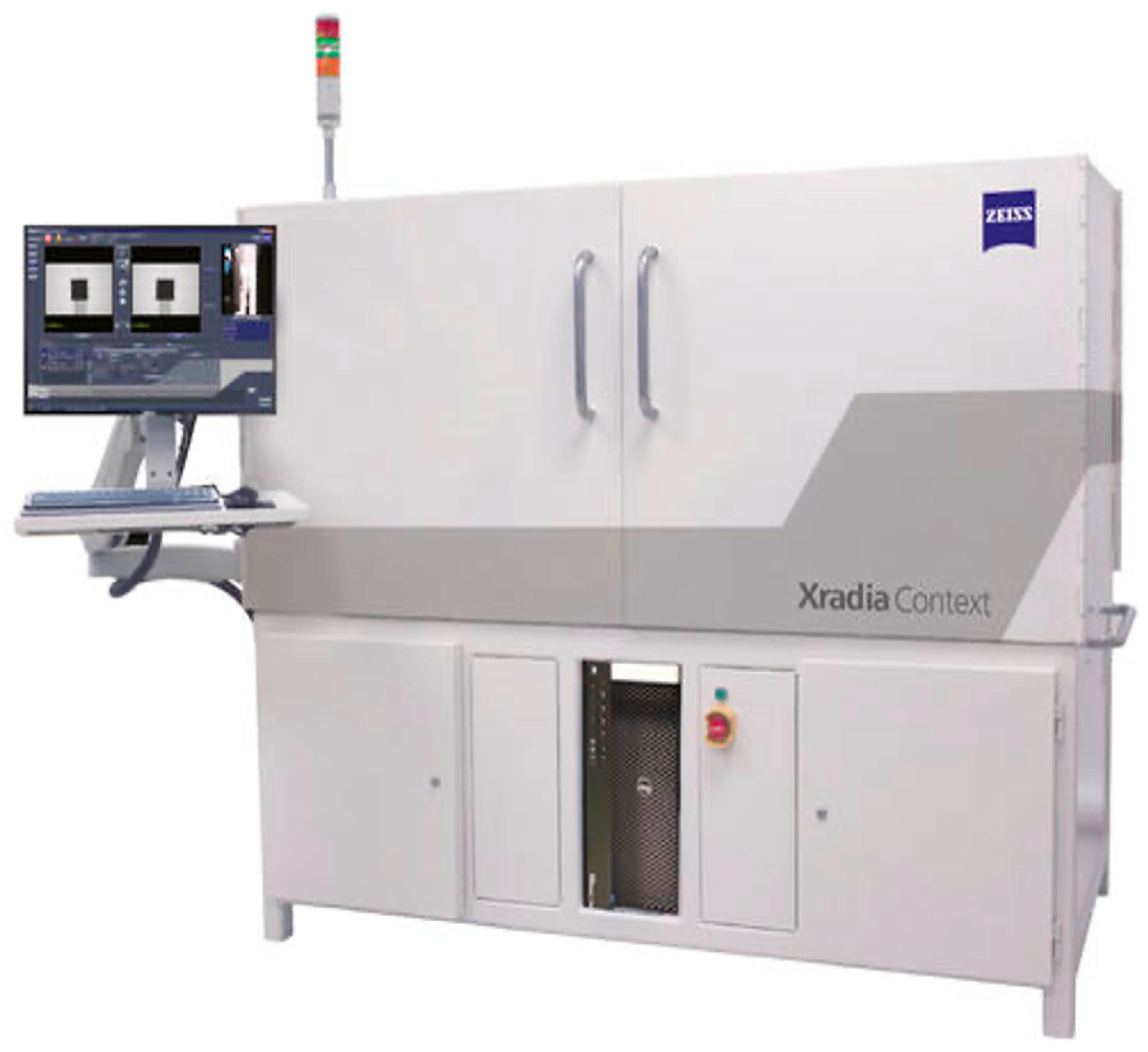
Appendix A.2. Raw Image Examples and Data Processing Outputs
- (a)
- Raw micro-CT 2D Slice Images
- (b)
- Throat and Pore Size Distribution Analysis
- (c)
- Reconstructed Digital Rock Models
- (d)
- 3D Pore Network and Skeleton Models

Appendix A.3. Summary of Microstructural Quantification Workflow
| Step | Description |
|---|---|
| 1 | Micro-CT scanning (pre- and post-flooding) using X-radia MicroXCT-400 |
| 2 | Image filtering and grayscale normalization |
| 3 | Thresholding and segmentation of pore space |
| 4 | Morphological analysis to extract size distributions |
| 5 | 3D reconstruction of digital rock |
| 6 | Network extraction and skeletonization for topological analysis |
| 7 | Pore classification based on size and local flux area |
References
- Hou, L.H.; Li, H.W.; Li, Q. Characteristics of oil and gas discoveries in recent 20 years and future exploration in the world. Pet. Explor. Dev. 2018, 23, 44–53. [Google Scholar]
- Zhang, H.; Shan, G.J.; Du, Q.L.; Wang, C.X. Technical challenges and solutions of water flooding development in late stage of ultra-high water cut in placanticline oilfield in Daqing. Pet. Geol. Oilfield Dev. Daqing 2022, 41, 60–66. [Google Scholar]
- Yuan, Q.F.; Pang, Y.M.; Du, Q.L.; Fang, Y.J.; Zhao, Y.F.; Lu, H.M. Development laws of the sandstone oilfields at extra-high watercut stage. Pet. Geol. Oilfield Dev. Daqing 2017, 36, 49–55. [Google Scholar]
- Liu, K.; Wang, R.; Shi, W.Z.; Martín, J.D.; Qi, R.; Zhang, W.; Qin, S.; Travé, A. Full scale of pore-throat size distribution and its control on petrophysical properties of the Shanxi Formation tight sandstone reservoir in the North Ordos Basin, China. Lithosphere 2023, 2022, 2358721. [Google Scholar] [CrossRef]
- Li, Q.; You, X.; Li, J.; Zhou, Y.; Lu, H.; Wu, S.; Yue, D.; Zhang, H. Pore structure and factors controlling shale reservoir quality: Acase study of Chang 7 Formation in the Southern Ordos Basin, China. Enerigies 2024, 17, 1140. [Google Scholar] [CrossRef]
- Keith, W.S.; Robert, M.C. The evolution of pore-scale fluid-saturation in low-permeability sandstone reservoirs. AAPG Bull. 2015, 99, 1957–1990. [Google Scholar]
- Coskun, S.B.; Wardlaw, N.C. Image analysis for estimating ultimate oil recovery efficiency by waterflooding for two sand-stone reservoirs. J. Petrol. Sci. Eng. 1996, 15, 237–250. [Google Scholar] [CrossRef]
- Zhou, Y.; Wu, S.; Li, Z.; Zhu, R.; Xie, S.; Zhai, X.; Lei, L. Investigation of microscopic pore structure and permeability prediction in sand-conglomerate reservoirs. J. Earth Sci. 2021, 32, 818–827. [Google Scholar] [CrossRef]
- Xiao, L.; Bi, L.; Yi, T.; Lei, Y.; Wei, Q. Pore structure characteristics and influencing factors of tight reservoirs controlled by different provenance systems: A case study of the Chang 7 Members in Heshui and Xin’anbian of the Ordos Basin. Energies 2023, 16, 3410. [Google Scholar] [CrossRef]
- Mu, C.; Hua, H.; Wang, X. Characterization of pore structure and reservoir properties of tight sandstone with CTS, SEM, and HPMI: A case study of the tight oil reservoir in fuyu oil layers of Sanzhao Sag, Songliao basin, NE China. Front. Energy Res. 2023, 10, 1053919. [Google Scholar] [CrossRef]
- Dai, Z.; Luo, D.L.; Xie, M.Y. A new method for particle size analysis of cuttings images based on improved watershed algorithm. China Offshore Oil Gas 2019, 31, 103–107. [Google Scholar]
- Jiang, Z.; Pan, Y.; Fu, C.; Li, W.; Wang, Y.; Long, W. Three-dimensional pore structure characterization of cement paste by X-ray computed tomography (XCT) and focused ion beam/scanning electron microscopy (FIB/SEM). Constr. Build. Mater. 2023, 383, 131379. [Google Scholar] [CrossRef]
- Bijoyendra, B.; Sushanta, K.; Douglas, V. Understanding the micro structure of Berea Sandstone by the simultaneous use of micro-computed tomography (micro-CT) and focused ion beam-scanning electron microscopy (FIB-SEM). Micron 2011, 42, 412–418. [Google Scholar]
- Gu, N.; Hu, W.; Gao, L.; Liu, G. Three-dimensional spatial microscopic characteristics and developmental influencing factors of tight gas layers in Hangjinqi Prospect Area, Ordos Basin, China. Energies 2024, 17, 399. [Google Scholar] [CrossRef]
- Sakdinawat, A.; Attwood, D. Nanoscale X-ray Imaging. Nat. Photonics 2010, 267, 840–848. [Google Scholar] [CrossRef]
- Ju, Y.; Gong, W.; Xie, H.; Chang, C.; Xie, L.; Liu, P. Three-dimensional characterisation of multi-scale structures of the Silurian Longmaxi shale using focused ion beam-scanning electron microscopy and reconstruction technology. J. Nat Gas Sci. Eng. 2017, 46, 26–37. [Google Scholar] [CrossRef]
- Dmitriy, A.M.; Shadfar, D.; Ali, K.; Masoud, R.; Yousef, K.; Ma, T.S. Multiscale and diverse spatial heterogeneity analysis of void structures in reef carbonate reservoirs. Geoenergy Sci. Eng. 2024, 233, 212569. [Google Scholar]
- Ali, A.A.; Namam, M.S.; Dmirriy, A.M. Paleoenvironmental evaluation using an integrated microfacies evidence and triangle model diagram: A case study from Khurmala Formation, Northeastern Iraq. J. Mar. Sci. Eng. 2023, 11, 2162. [Google Scholar]
- Ju, Y.; Xi, C.; Zheng, J.; Gong, W.; Wu, J.; Wang, S.; Mao, L. Study on three-dimensional immiscible water–Oil two-phase dis-placement and trapping in deformed pore structures subjected to varying geostress via in situ computed tomography scanning and additively printed models. Int. J. Eng. Sci. 2022, 171, 103615. [Google Scholar] [CrossRef]
- Zhang, J.; Sun, J.; Cao, Y.; Zhong, X.; Li, S. Research of micro-pore structure and seepage characteristics of Portugal Reservoir in Lamadian Oilfield. Miner. Explor. 2023, 14, 1402–1411. [Google Scholar]
- Wang, J.; Wu, S.; Xiao, S.; Guo, S.; Lv, Z.; Jiao, H.; Guo, Z.; Liu, Z.; Wu, H.; Xiao, Q. Distribution characteristics of micropore throat size of turbidite sandstone reservoir in middle sub-member of 3rd member, Shahejie Formation in Dongying Depression. J. China Univ. Pet. 2021, 45, 12–21. [Google Scholar]
- Lin, J.; Yang, Y.; Yin, J.; Liu, Y.; Li, X. Study on pore structure evolution characteristics of weakly cemented sandstone under freeze–thaw based on NMR. Water 2023, 15, 281. [Google Scholar] [CrossRef]
- Chen, D.; Zhu, Y.; Wang, W.; Zhang, L.; Tang, J.; Ren, J.; Wang, Y. Pore structure of tight sandstones with differing permeability: The He 8 Member of the Middle Permian Lower Shihezi Formation, Gaoqiao area, Ordos Basin. Energy Sci. Eng. 2024, 12, 117–135. [Google Scholar] [CrossRef]
- Zhang, Q.; Qi, H.; Huo, Y.; Li, Y.; Li, T.; Zhang, D.; Lin, K.; Yang, C.; Tong, J.; Zhao, H.; et al. Study of pore-throat structure characteristics and fluid mobility of Chang 7 tight sandstone reservoir in Jiyuan area, Ordos Basin. Open Geosci. 2023, 15, 20220534. [Google Scholar] [CrossRef]
- Chen, C.; Fu, L.; Chen, X.; Zhang, T.; Xie, Y.; Wang, H.; Zhu, Y. Quantitative Evaluation Method for Micro Heterogeneity of Tight Sandstone: A case study of Chang-6 reservoir of Yanchang Formation in Huaqing area, Ordos Basin. Acta Sedimentol. Sin. 2021, 39, 1086–1099. [Google Scholar]
- Gong, W.; Liu, Y.; Xi, C.; Ju, Y.; Wang, M. Dynamic characterization of residual oil during long-term waterflooding experiments in heterogeneous porous structures. Fuel 2024, 356, 129567. [Google Scholar] [CrossRef]
- Ren, X.; Li, A.; Wang, Y.; Wu, S.; Wang, G. Pore structure of tight sand reservoir and its influence on percolation-taking the Chang 8 reservoir in Maling oilfield in Ordos basin as an example. Oil Gas Geol. 2015, 36, 774–779. [Google Scholar]
- Guo, H.; Liu, Q.; Li, H.; Meng, Z.; Bai, Y. Characteristics of pore structure of Jurassic tight reservoir in Sichuan basin. J. Shenzhen Univ. 2013, 30, 306–312. [Google Scholar] [CrossRef]
- Pei, Z.; Zhou, Z.; Chang, W.; Zhang, Y. Type division and reservoir characteristics of micro-pore structure in S area of Daqing placantieline. Pet. Geol. Eng. 2022, 36, 82–87. [Google Scholar]
- Lin, W.; Li, X.; Yang, Z.; Xiong, S.; Luo, Y.; Zhao, X. Modeling of 3D rock porous media by combining X-Ray CT and Markov chain Monte Carlo. J. Energy Resour. Technol.-Trans. ASME 2020, 142, 013001. [Google Scholar] [CrossRef]
- Yun, L. Reconstruction and analysis of tight sandstone digital rock combined with X-ray CT scanning and multiple-point geostatistics algorithm. Math. Probl. Eng. 2020, 2020, 9476060. [Google Scholar]
- Song, R.; Wang, Y.; Liu, J.; Cui, M.; Lei, Y. Comparative analysis on pore-scale permeability prediction on micro-CT im-ages of rock using numerical and empirical approaches. Energy Sci. Eng. 2019, 7, 2842–2854. [Google Scholar] [CrossRef]
- Fatt, I. The network model of porous media. SPE 1956, 207, 144–159. [Google Scholar] [CrossRef]
- Liu, Y.; Gong, W.; Zhao, Y.; Jin, X.; Wang, M. A Pore-Throat Segmentation Method Based on Local Hydraulic Resistance Equivalence for Pore-Network Modelling. Water Resour. Res. 2022, 58, e2022WR033142. [Google Scholar] [CrossRef]
- Meng, J.; Zhang, L.Y.; Li, R.; Zhao, A.F.; Zhu, B.W.; Huang, P.; Shen, S.B. Microscopic pore structure characteristics of tight sandstone reservoirs and its classification evaluation. Spec. Oil Gas Reserv. 2023, 30, 71–78. [Google Scholar]
- Pang, Y.; Liu, Y.; Zhang, L.; Xi, N.; Yuan, L.; Chen, C. Micro-pore structure and fluid mobility of tight sandstone reservoirs of Chang 8 menber in Huachi area in Ordos basin. Pet. Geol. Oilfield Dev. Daqing 2023, 42, 1–10. [Google Scholar]
- Ran, X.; Wu, S.; Fu, J.; Wei, X.; Chu, M. Research on the pore structure classification of low permeability reservoir of the Yanchang formation in Longdong area, Ordos basin. Earth Sci. Front. 2013, 20, 77–85. [Google Scholar]
- Yang, Y.; Li, Y.; Yao, J.; Zhang, K.; Iglauer, S.; Luquot, L.; Wang, Z. Formation damage evaluation of a sandstone reservoir via pore-scale X-ray computed tomography analysis. J. Pet. Sci. 2019, 183, 106356. [Google Scholar] [CrossRef]
- Wang, F.; Wang, X.; Liu, Y.; Deng, Q.; Xu, J.; Zhang, Y.; Li, H. The Evolutionary Characteristics of Reservoir Microstructure under Long-Term Waterflooding Development and Its Fractal Description. Geofluids 2021, 1, 5557125. [Google Scholar] [CrossRef]
- Zhou, Y.; Yang, W.; Yin, D. Experimental investigation on reservoir damage caused by clay minerals after water injection in low permeability sandstone reservoirs. J. Pet. Explor. Prod. Technol. 2022, 12, 915–924. [Google Scholar] [CrossRef]
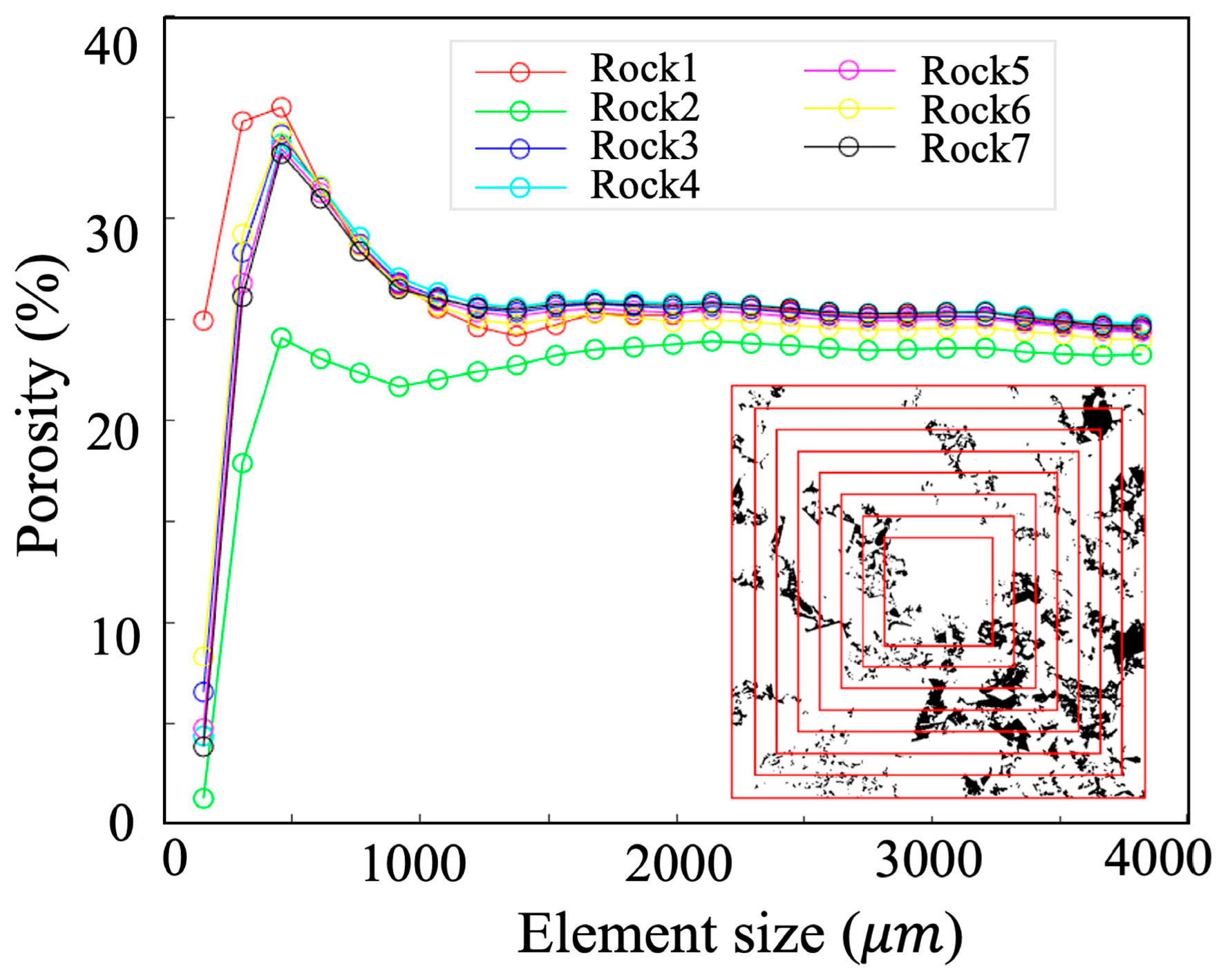




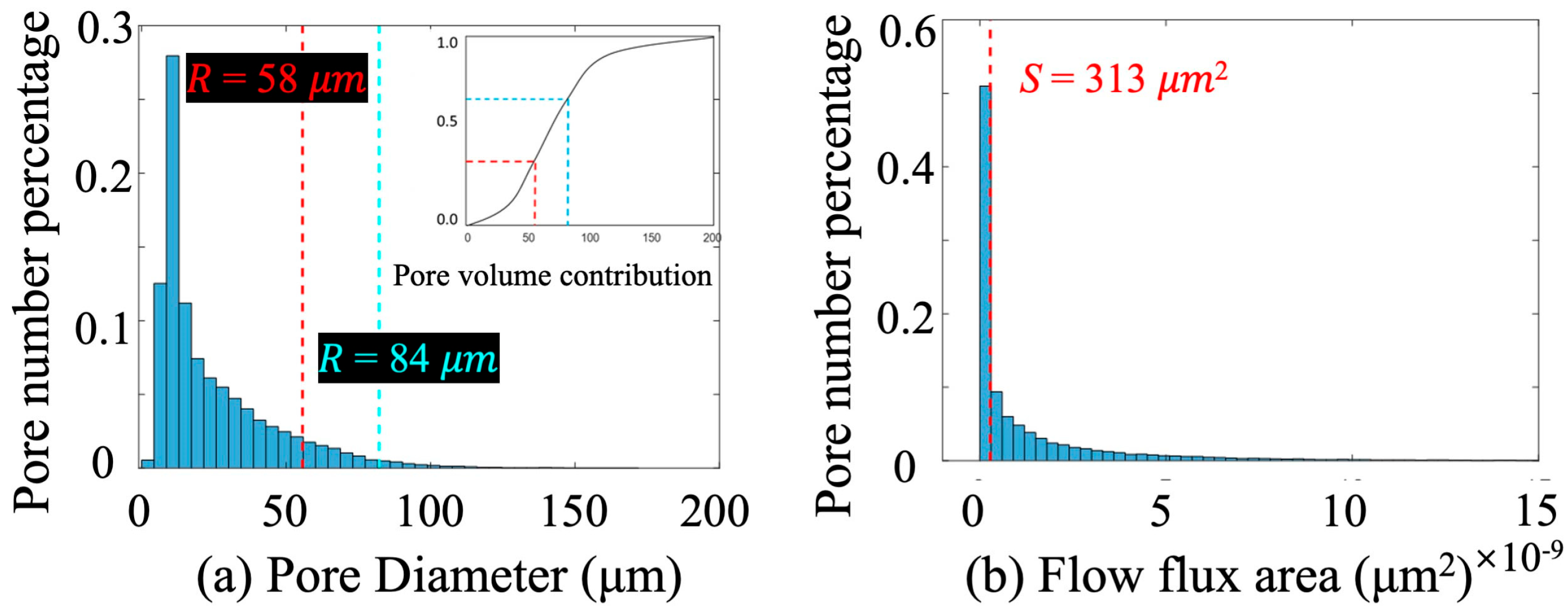



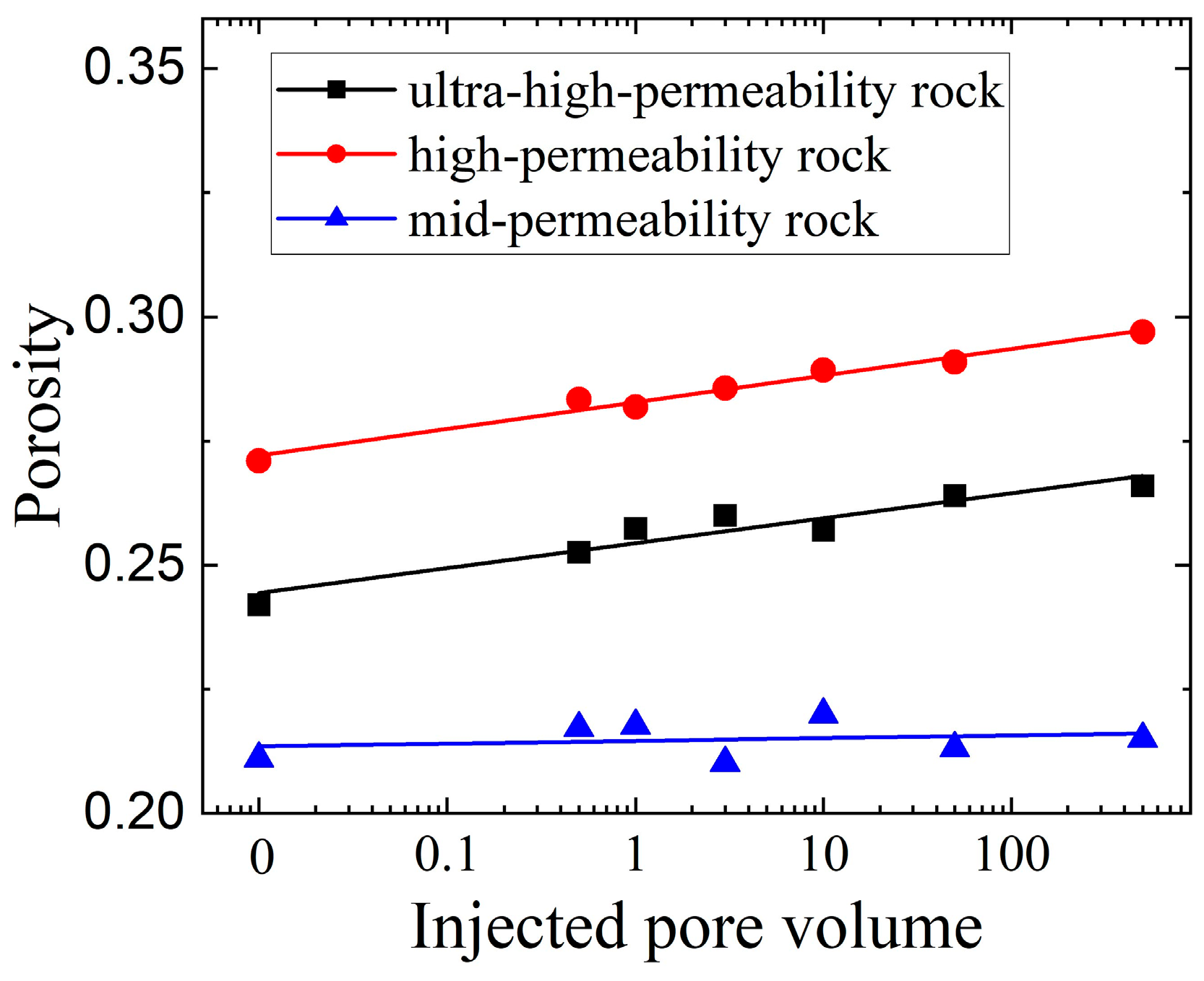
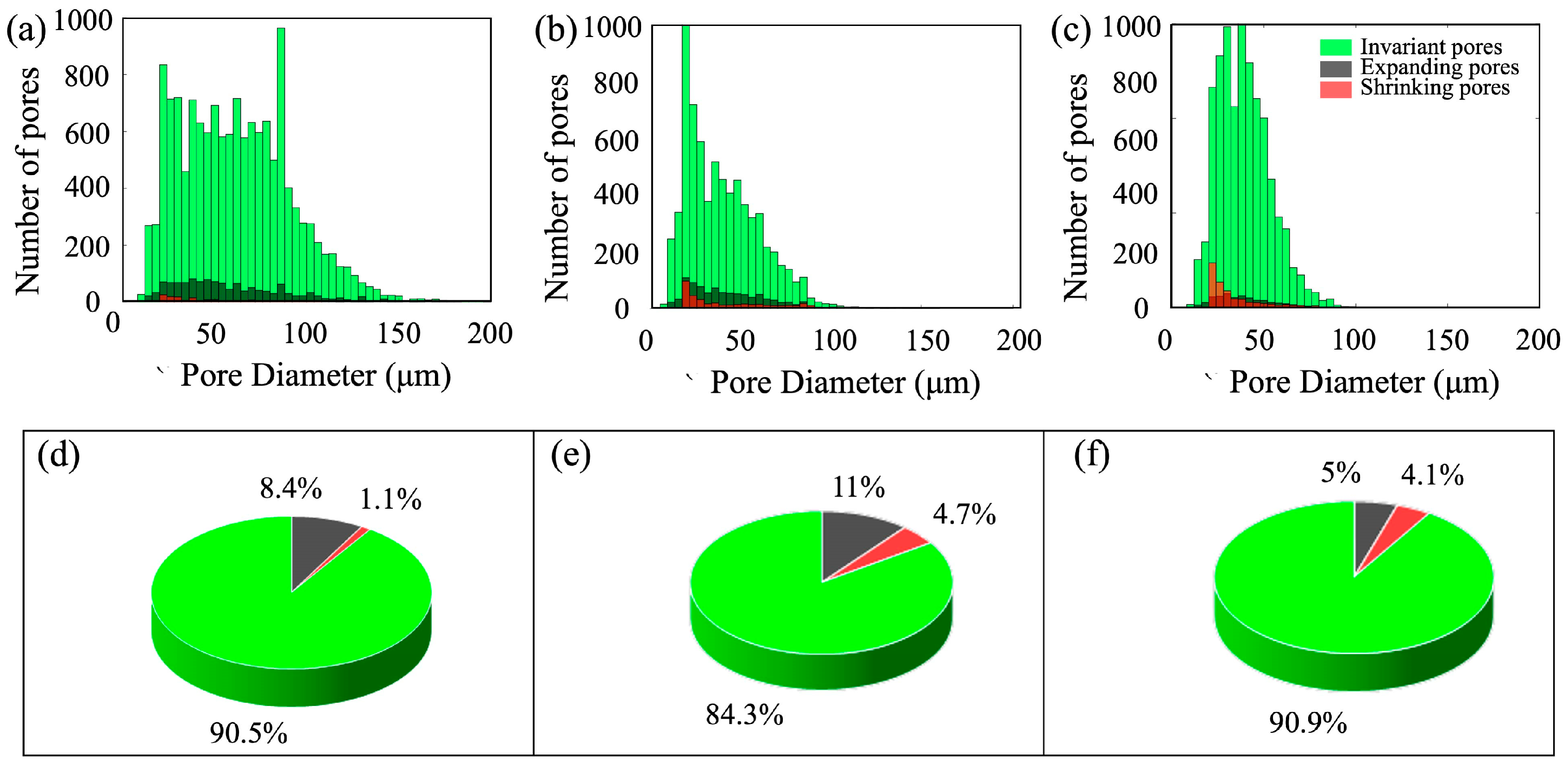
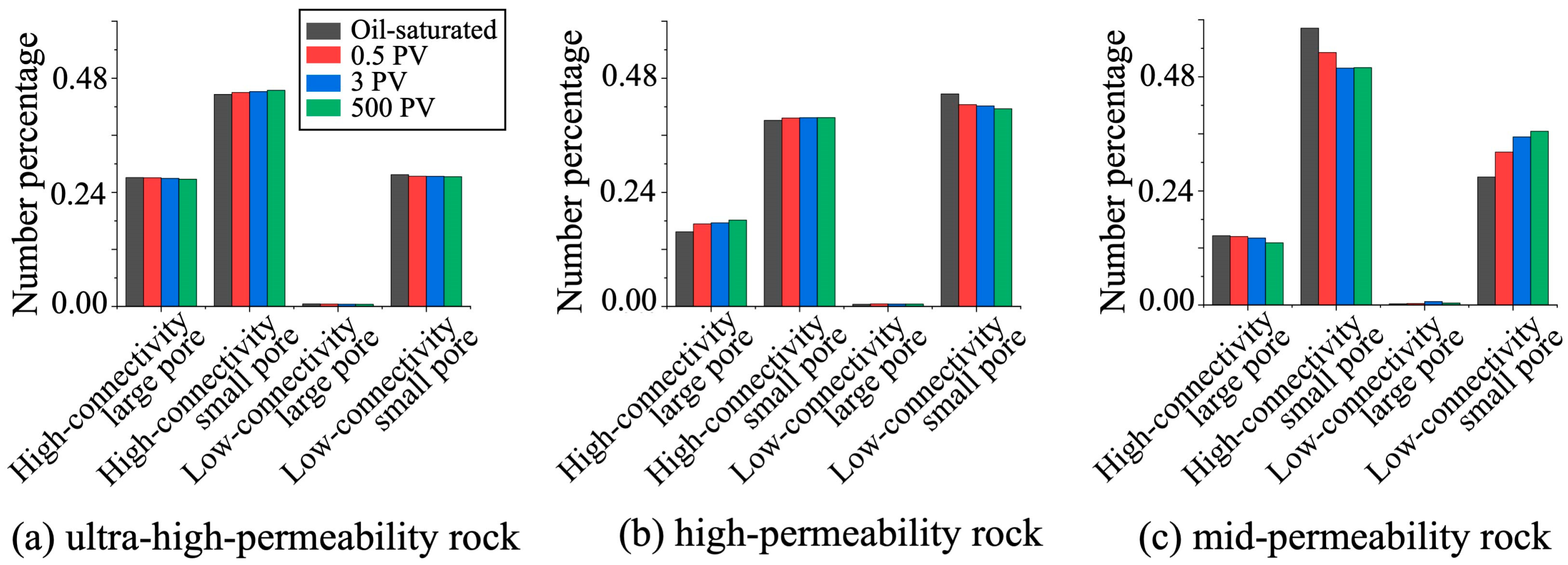
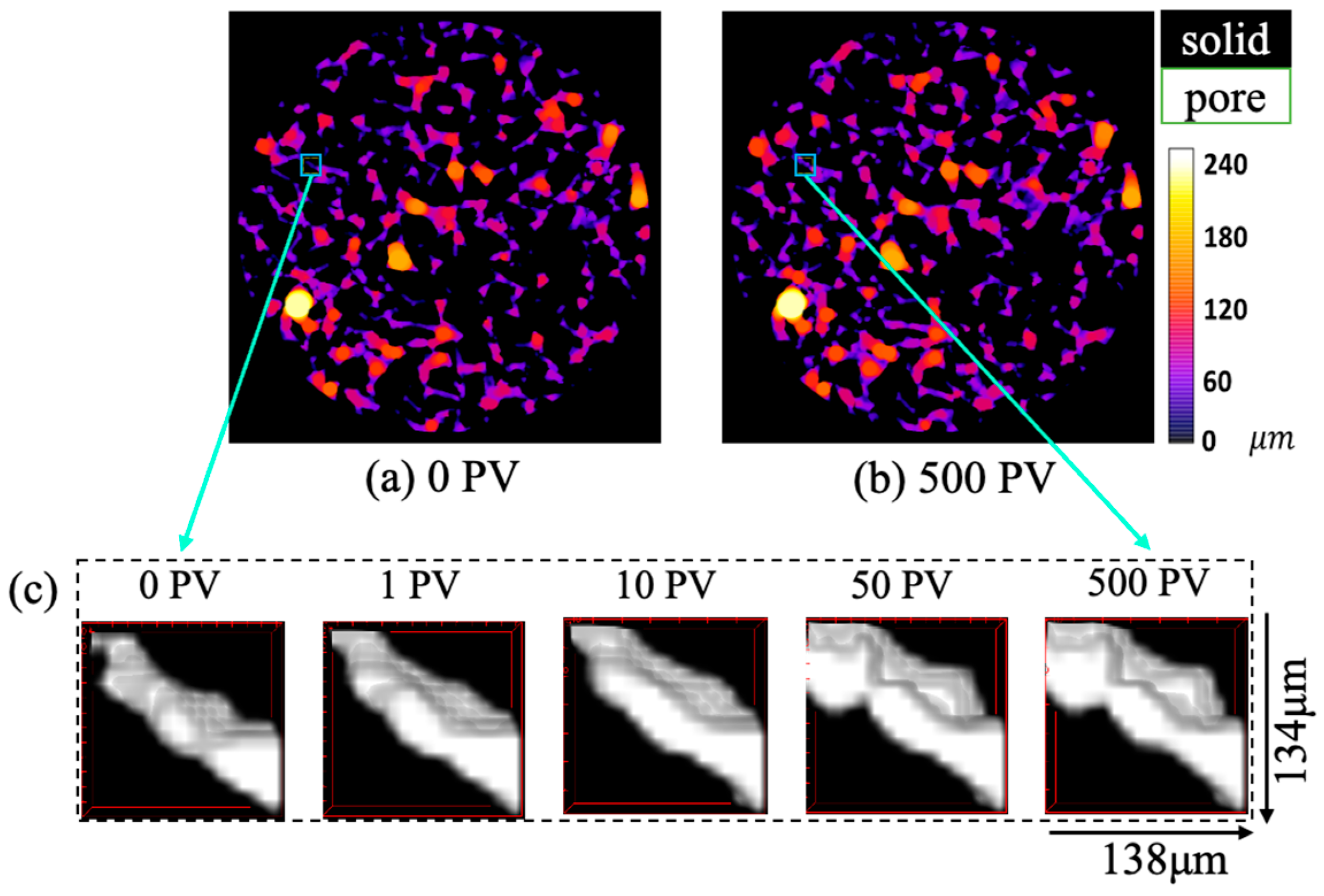
| Sample Number | Reservoir Type | Lithologic Feature | Porosity (%) | Permeability (10−3 μm2) | Length (cm) | Diameter (cm) |
|---|---|---|---|---|---|---|
| 1 | Ultra-high-permeability reservoir | Fine sandstone | 30.96 | 3956 | 3.53 | 2.47 |
| 2 | Ultra-high-permeability reservoir | Fine sandstone | 30.26 | 2568 | 3.83 | 2.47 |
| 3 | High-permeability reservoir | Siltstone | 29.32 | 1890 | 4.94 | 2.49 |
| 4 | High-permeability reservoir | Siltstone | 28.84 | 1398 | 4.73 | 2.48 |
| 5 | Medium-permeability reservoir | Siltstone | 27.79 | 381 | 4.03 | 2.47 |
| 6 | Medium-permeability reservoir | Siltstone | 27.33 | 238 | 3.91 | 2.48 |
| Reservoir Type | Sample Number | Resolution Size (μm/voxel) | Dimension Size (μm) | Boundary Condition | Reynolds Number |
|---|---|---|---|---|---|
| Ultra-high-permeability and high-permeability reservoirs | 24 | 2, 4, 8 | 800, 1200, 1600, 2000 | Pressure Boundary | ~0.01 |
| Medium-permeability reservoir | 5 | 1, 2, 4 | 440, 520, 580, 640 |
| Pore Structure Type | Criteria for Classification | ||
|---|---|---|---|
| Pore Diameter/μm | Flux Area/μm2 | ||
| Large pore | High connectivity | >84 | >313 |
| Low connectivity | >84 | ≤313 | |
| Medium pore | High connectivity | (58, 84] | >313 |
| Low connectivity | (58, 84] | ≤313 | |
| Small pore | High connectivity | ≤58 | >313 |
| Low connectivity | ≤58 | ≤313 | |
| Sample Size | Diameter 4 mm, Length 8 mm, Scanning Resolution 2 μm | |||||||
|---|---|---|---|---|---|---|---|---|
| Displacement Nodes | Dry Sample | Oil Injection | 0.5 PV | 1.0 PV | 3.0 PV | 10.0 PV | 50.0 PV | 500.0 PV |
| Displacement Speed (μm/s) | / | / | 11 | 11 | 11 | 33 | 110 | 110 |
Disclaimer/Publisher’s Note: The statements, opinions and data contained in all publications are solely those of the individual author(s) and contributor(s) and not of MDPI and/or the editor(s). MDPI and/or the editor(s) disclaim responsibility for any injury to people or property resulting from any ideas, methods, instructions or products referred to in the content. |
© 2025 by the authors. Licensee MDPI, Basel, Switzerland. This article is an open access article distributed under the terms and conditions of the Creative Commons Attribution (CC BY) license (https://creativecommons.org/licenses/by/4.0/).
Share and Cite
Wu, J.; Gong, W.; Wang, Q.; He, Y.; Guo, J.; Bao, Y.; Shao, S.; Li, R. Dynamic Characterization of Microscopic Pore Structure in Medium–High Permeability Sandstones During Waterflooding. Nanomaterials 2025, 15, 747. https://doi.org/10.3390/nano15100747
Wu J, Gong W, Wang Q, He Y, Guo J, Bao Y, Shao S, Li R. Dynamic Characterization of Microscopic Pore Structure in Medium–High Permeability Sandstones During Waterflooding. Nanomaterials. 2025; 15(10):747. https://doi.org/10.3390/nano15100747
Chicago/Turabian StyleWu, Jiayi, Wenbo Gong, Qingyu Wang, Yuhang He, Junhui Guo, Yi Bao, Shuai Shao, and Rubin Li. 2025. "Dynamic Characterization of Microscopic Pore Structure in Medium–High Permeability Sandstones During Waterflooding" Nanomaterials 15, no. 10: 747. https://doi.org/10.3390/nano15100747
APA StyleWu, J., Gong, W., Wang, Q., He, Y., Guo, J., Bao, Y., Shao, S., & Li, R. (2025). Dynamic Characterization of Microscopic Pore Structure in Medium–High Permeability Sandstones During Waterflooding. Nanomaterials, 15(10), 747. https://doi.org/10.3390/nano15100747




